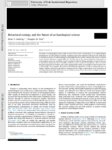1 - 25 of 8
| Creator | Title | Description | Subject | Date | ||
|---|---|---|---|---|---|---|
| 1 |
 |
Loeb, Laurence D. | Prestige and piety in the Iranian synagogue | Among Iranian Jews, long deprived of meaningful political power and afraid to conspicuously display material wealth, relative prestige became more valued that authority of opulence. The synagogue provides the traditional public forum where meaningful interaction among its members reinforces rand dif... | Shirazi Jewish Socieity | 1978 |
| 2 |
 |
Rogers, Alan R. | Quantitative genetics of sexual dimorphism in human body size | A classical data set is used to predict the effect of selection on sexual dimorphism and on the population means of three characters--stature, span, and cubit--in humans. Given selection of equal intensity, the population means of stature and of cubit should respond more than 60 times as fast as d... | Societies; Selection; Species | 1992 |
| 3 |
 |
O'Connell, James F. | A Different Paradigm for the Initial Colonisation of Sahul: Archaeological, genetic, demographic and geographic perspectives | The questions of when and how humans reached Sahul, the Pleistocene continent of Australia and New Guinea, has remained a central issue of Australian archaeology since its development as an academic discipline in the mid-twentieth century. Additionally, this has been a dominant theme linking Austral... | Sahul; Wallacea; colonisation; isolation; genomics; mitochondrial DNA | 2019-08-20 |
| 4 |
 |
Codding, Brian F. | Socioecological dynamics structuring the spread of farming in the North American Basin-Plateau Region | The spread of agriculture is a major driver of social and environmental change throughout 25 the Holocene, yet experimental and ethnographic data indicate that farming is less profitable than foraging, so why would individuals choose to adopt agriculture leading to its expansion? Ideal distribution ... | Ideal free distribution model; population ecology; behavioral ecology; maize agriculture; Ancestral Puebloan; Fremont Complex | 2021 |
| 5 |
 |
Cashdan, Elizabeth A. | Competition between foragers and food producers on the Botletli River, Botswana | The immigration of food-producing groups into areas occupied by hunters and gatherers must have been a common occurrence in prehistory. How were the hunter-gatherers affected by this? I describe here two groups of Kalahari Basarwa ('Bushmen'), one living along the flood plain of the lower Botletli ... | Kalahari Basarwa; Bushmen; Foraging; Cattle | 1986 |
| 6 |
 |
Codding, Brian | Behavioral ecology and the future of archaeological science | The future of archaeological science relies as much (if not more) on theoretical as on methodological developments. As with anything in biology, explaining past human behavior will require the application of evolutionary theory. As with anything in archaeology, theory is useless without clear ties t... | 2015-01-01 | |
| 7 |
 |
Wiessner, Pauline W. | Wealth transmission and inequality among hunter-gatherers | We report quantitative estimates of intergenerational transmission and population-wide inequality for wealth measures in a set of hunter-gatherer populations. Wealth is defined broadly as factors that contribute to individual or household well-being, ranging from embodied forms, such as weight and h... | 2010-02 | |
| 8 |
 |
Rogers, Alan R. | Genetic variation at the MCIR Locus and the time since loss of human body hair | The melanocortin I receptor (MCIR) locus makes a protein that affects the color of skin and hair. At this locus, amino-acid differences are entirely absent among African humans, abundant among non-Africans (especially Europeans), and abundant in chimpanzee/human comparisons (Rana et al. 1999, Hardin... | Nonsynonymous; Chimpanzee; Constraint | 2004 |
1 - 25 of 8
